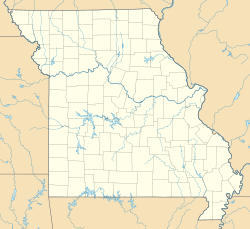Gumbo Point Archeological Site facts for kids
Quick facts for kids |
|
|
Gumbo Point Archeological Site
|
|
| Nearest city | Malta Bend, Missouri |
|---|---|
| Built | ca1725 |
| NRHP reference No. | 69000125 |
The Gumbo Point Site is an important Native American archaeological site. It is located in Saline County, Missouri, close to the Missouri River. You can find it north of the town of Malta Bend. This site was recognized as a National Historic Landmark in 1969. This means it is a very special place in American history.
Discovering Gumbo Point: An Ancient Village
Since 1939, people have been digging at the Gumbo Point Archeological Site. These digs, called excavations, have found many interesting items. These items, or artifacts, show us how two Native American tribes, the Little Osage and the Missouri Indians, interacted.
Archaeologists, who are like history detectives, believe there are still many more important things to discover here. The site helps us understand how these tribes lived and shared their cultures.
Life at Gumbo Point: A Look Back
The Missouria tribe lived at a place called the Utz site for a long time. They stayed there even after they first met Europeans. Around 1714, some of the Missouria people moved. They went from their village on a ridge to a large flat area called the Petitesas Plain.
This new location, known as Gumbo Point, was very helpful. It gave the tribe easier access to Fort Orleans, a French trading post. After the fort closed, it was still a good spot for trading with people traveling along the Missouri River.
Life changed for the Missouria and Osage tribes when France gave control of Louisiana to Spain in 1762. Spanish officials were suspicious of some tribes. They took strict actions against the Big Osage, Little Osage, and Missouria. This made life very difficult for these tribes.
The Missouria tribe lived at Gumbo Point until the late 1700s. They faced many challenges during this time. There were conflicts with other tribes, like the Sauk and Fox. They also suffered from widespread illnesses. Because of these difficulties, they eventually moved west.
By 1794, the Missouria tribe was much smaller. Some survivors joined the Little Osage and the Kansa tribes. A larger group, about 80 people, joined the Otoe tribe near the Platte River. Later, in 1882, the Missouria people were moved to Oklahoma along with the Otoe. The last full-blooded Missouria Indian passed away in 1907.



